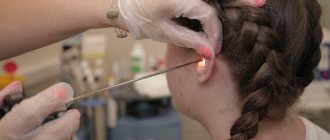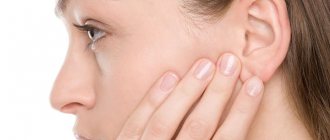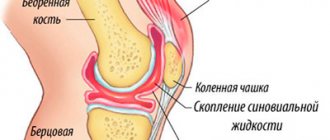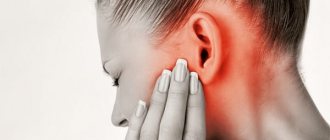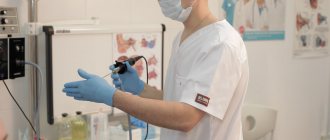What is ear discharge?
Often the cause of ear discharge is inflammation of the ear canal, which can have various causes and always requires medical attention. This is an acute secretion of secretion from the auditory canal through the auricle. The fluid passes through the ear canal; in severe cases, the secretion drips onto clothing, which can be quite uncomfortable for the patient.
This discharge may be purulent or even bloody and always suggests pathological inflammation of the ear or eardrum. Patients usually experience severe ear pain in the ear and other symptoms such as fever or dizziness.
Discharge from the ear can be an unpleasant manifestation when chronic for the patient, causing constant itching in the external auditory canal.
What to do if your ear is blocked from water and hurts
It often happens that the feeling of the presence of water in the ear is painful, and the above first aid methods do not help. The best option in this case is to seek qualified medical help. But if your ear is blocked from water and hurts, but there is no possibility of visiting a doctor, then you can do the following:
- Make a flagellum out of cotton wool and clean your ear with it. A cotton (ear) swab is not suitable for this procedure, since it cannot absorb water, which is the primary task.
- You can simply lie on a flat surface (without a pillow) on the side where your ear is blocked. Under the weight of your head, the water will come out on its own and relief will come.
- If sea water gets into the ear and does not come out, then you can drip 1-2 drops of alcohol and wait 3-5 minutes. The alcohol mixes with water and evaporates. This method can be used to solve problems not only in adults, but also in children.
- If water gets into the ear after swimming, hydrogen peroxide can be used. This solution is injected into the problem area in the amount of 1-2 drops, then the earlobe is pulled down a little and back to the back of the head. In this case, the water will penetrate a little further along the ear canal (this is usually felt), but there is no need to worry, since it will evaporate quite quickly when mixed with hydrogen peroxide.
If water gets into a newborn's ear while bathing, the only way to remove it is with a cotton swab! You should not take the methods described above; it is better to seek help from a doctor. Many parents simply cannot understand which ear the water got into and whether there is a problem at all. To get rid of doubts, after bathing the baby, you must first put it on one side, then (after a few seconds) on the other - the water should flow out on its own.
Causes
The causes may be inflammation of the ear canal, into which effusion occurs from the inflamed areas of the ear canal. Or it could be a middle ear infection (otitis media) - in which fluid leaks from a hole in the eardrum.
While inflammation of the ear canal often occurs as a result of traumatic manipulation and the subsequent penetration of pathogens into the damaged areas, inflammation of the middle ear has bacterial causes that cause this symptom.
Both types of inflammation can usually be very painful. In addition to ear discharge, general weakness, fever, (stabbing) pressure in the ears, decreased hearing, as well as dizziness and balance problems may occur.
Chewing movements
If you don’t have a napkin on hand or for some reason you don’t want to follow the method described above, here are a few more methods for getting rid of water. They do not work for everyone and are not as effective, so their use is at your discretion.
A fairly popular technique is chewing movements , as a result of which water can be pushed out under the influence of muscle reflexes.
Procedure:
- Lie on your side so that your ear with water is down.
- Chew chewing gum in this position or imitate chewing movements.
- Swallow while chewing.
Chewing and swallowing can help move water out.
Establishing diagnosis
In case of discharge and pain in the ears, you should always consult a doctor so that an accurate diagnosis can be made.
At worst, untreated ear infections can become chronic and affect the patient for the rest of their life. A number of studies and tests are offered to make a diagnosis. The doctor will first check your medical history to determine which symptoms are present. He will then examine the ear canal more closely using an ear mirror (otoscopy), whereby he will visually examine the inner ear using an ear specula. Inflammation, with local hyperemia or bulging of the eardrum, is noticeable even during the initial examination.
If necessary, the ENT doctor can additionally check the mobility of the eardrum and how well the Eustachian tube functions.
How to expel using a vacuum
Three methods can be mentioned here :
1. Place your palm on your bowed head and apply pressure . Then, sharply tear your hand away.
The principle of operation is the same as when using a plunger to clean pipes: we push out the air, and due to the resulting vacuum, water is sucked in.
2. Close the ear canal with your finger:
With your other hand, pull back your earlobe - this will create a vacuum (the volume of the canal will increase, but there will be no more air in it). Then quickly remove your finger.
3. You can also lean forward strongly and straighten up sharply so that centrifugal forces appear in the ear, due to which the water is pressed against one of the walls and then pours out. This technique is not recommended for people who have back problems or other medical contraindications to such sudden movements.
Complications
Discharge from the ear is not only an unpleasant symptom, but can also cause a serious illness. This is usually otitis externa, but the doctor must rule out more severe pathologies.
The discharge may be bloody or purulent, in which case it indicates inflammation of the eardrum or middle ear. This discharge is accompanied by severe pain, and patients often suffer from dizziness or fever. Discharge is quite an uncomfortable symptom for the patient, even if there are no accompanying symptoms. Because it causes tingling or itching in the ear, and often the fluid has a foul odor.
Drying with a hairdryer
Blow-drying also works for some people, although the method itself cannot be called completely safe.
Take a hairdryer, turn it on to cold air and place it at a distance of at least 30 centimeters from the ear:
The incoming air flow can dry out the ear canal.
Be careful with this method - the main thing here is not to burn your ear with warm air and not to overcool it with cold air.
Instead of a hairdryer, you can also use an enema - just under no circumstances insert it into the ear, but blow from the enema at a distance.
When should you see a doctor?
The discharge may be the usual overproduction of sebum and earwax. If this manifestation is not chronic, then it usually does not require any medical intervention - basic hygiene is sufficient.
However, it is better to entrust the cleaning of the ear canal to an ENT specialist. Especially when it comes to hearing loss, when self-cleaning does not occur.
If there is greenish discharge with an unpleasant odor, this indicates a bacterial infection. In this case, a doctor's examination is required. The sooner treatment begins, the lower the likelihood of permanent damage to the inner ear.
A visit to the doctor is also important if ear discharge is accompanied by pain or bloody discharge. This may be a sign of internal ear injury.
Cleaning ears with wax plugs
People most often come to an otolaryngologist with complaints about earwax. In this case, patients experience hearing impairment, the cause of which is clogging of the ear canal with sulfur. The substance contains a lubricating secretion of glands and keratinized epithelial particles.
Often, a noticeable decrease in the ability to perceive sounds is observed after taking water procedures, swimming, when water gets into the ears. The cause of aching or sharp “shooting” pain is swelling of the conglomerate. If you have pain symptoms, you should contact a medical facility as soon as possible; you should not try to clear wax from your ears on your own, as this can lead to the development of complications.
Treatment and therapy
Treatment for such manifestations depends on the cause. First of all, in the treatment of all ear infections, decongestant ear drops are always used to better drain the discharge.
For pain, certain analgesics can be used. These drugs are also used as an antipyretic. If a bacterial infection is present, antibiotics are used for treatment. In some cases, local rinsing with both solutions of anti-inflammatory drugs and ordinary boiled water is recommended. This may speed up the healing process.
If a large volume of exudate accumulates behind the eardrum, a puncture may be performed. To improve the outflow of pus and administer medications. Additionally, physiotherapeutic treatment may be used.
Signs of ear plug formation
Sulfur plugs often form completely unnoticeably. When pain or uncharacteristic sound effects appear, many suspect otitis media, although such pathological symptoms often indicate the formation of sulfur accumulation.
Most often, sulfur plugs make themselves felt after swimming. The development of pathological processes can be suspected by the following symptoms:
- pain, itching;
- unusual noise, crackling;
- feeling of fullness;
- you can hear your own echo in your head;
- discomfort when chewing food;
- distortion of sounds or hearing loss.
Situations where cerumen plug has formed next to the eardrum are the most dangerous. The patient may experience weakness, cough, dizziness and nausea, but there are no typical symptoms of colds.
It is necessary to visit an otolaryngologist as soon as possible. You should not use folk remedies or try to solve the problem yourself. Inadequate treatment can negatively affect your health. It is important to carry out therapy correctly and in a timely manner.
Medical offers to make an appointment with an otolaryngologist (ENT) of the highest category. A full range of diagnostics and treatment of ENT diseases in Tula. Tel. for recording.
Possible forecast
If an additional bacterial infection occurs during a simple inflammation, the discharge has an unpleasant odor and turns greenish-yellow in color.
The long-term existence of such a lesion can lead to a chronic course. And this can already lead to serious hearing impairment. In almost every case, this indicates the spread of inflammation to the deeper organs of hearing, including the eardrum.
If, despite adequate conservative therapy, no improvement is observed, invasive or surgical treatment may be used.
Ear plugs: main causes
The ears have a complex structure; the sulfur glands perform a protective function. The external auditory canal connects the eardrum to the outside world and is a curved, hollow tube. The outer part of the passage has a membranous-cartilaginous structure, the inner part has a bone structure. The outer part contains sulfur glands.
The number of sulfur glands can reach two thousand. Harmful microorganisms and dust particles stick to the secretion they produce. This is how the protection system works, preventing infectious agents and debris from entering the deep places of the ear canal. The skin of the ear canal regenerates very quickly, and epithelial cells divide in an outward direction. There is a constant production of sulfur; up to 20 mg of secretion can be formed per day. This mass gradually moves towards the entrance along with added contaminants. This process is usually invisible to a healthy person. Daily cleaning of the vestibule of the ear canal and wiping the outer part with water ensures comfortable cleaning of accumulated wax.
What is the reason for the accumulation of secretion in the ear? Ear wax can form due to improper cleaning or neglect of personal hygiene rules.
Often people use a cotton swab to push the sulfur into the bone region, trying to immerse it as deeply as possible. Such manipulations damage the skin of the ear canal, which causes increased secretion production. This mass is formed in large quantities and does not have time to come out on its own, it is compressed. Diseases of the digestive system and metabolic disorders can also create a violation of the consistency of the sulfur glands or increased secretion.
Some factors can cause hearing loss:
- genetic predisposition (increased viscosity of gland secretions, excessive hair growth, and some structural features of the canal are often inherited);
- staying in areas where there are sharp changes in atmospheric pressure (swimming at great depths, hiking in the mountains);
- frequent inflammatory processes in the nasopharynx during ARVI (enlarged adenoids in children with a chronic inflammatory process can cause ear plugs);
- the use of in-ear headphones and other sound amplifiers (long telephone conversations cause increased release of conglomerate);
- various skin diseases (the outflow of sulfur can be complicated due to psoriasis, dermatitis; inflammatory processes of the skin affect the cartilaginous part of the canal).
Poor nutrition can also cause increased secretion production. The presence of a high concentration of cholesterol in the blood makes sulfur viscous and accelerates hair growth.
Allowed self-medication
The pathological condition of the ear canal causes discomfort in the patient, so many try to be treated at home. Incorrect treatment will not help get rid of the problem, but can cause additional negative effects. When using cotton swabs, toothpicks, matches and other long thin objects, serious complications can develop. The secretion of the sulfur glands does not come out, but is pushed even deeper. As a result, the problem worsens and unpleasant symptoms intensify.
If there is no fever or pain, you can try to get rid of the plug without visiting the hospital. To dissolve it, medicinal drops and pharmaceutical solutions are used. “A-Cerumen” or “Remo-vax”, 3% hydrogen peroxide are popular remedies that can help in this situation. They should be used strictly according to the instructions. Pharmacists can offer herbal suppositories or herbal funnels, however, these drugs can aggravate the process and their use is not recommended.
Prevention
Carrying out regular preventative measures will minimize the likelihood of wax plugs. It is necessary to keep the ear canals clean and regularly remove secretions. Cotton swabs should not be used. Such household items can compact wax and clog the ear canal, damage the upper layers of the epidermis and cause inflammation.
Cosmetic cotton swabs are most often used after water procedures: washing hair, washing in the shower, taking a bath. A cotton swab is not able to dry the ears, but warm boric alcohol accelerates the evaporation of water. It is enough to drop 4-5 drops of the product into each passage, then lower your head and dry your ears with a towel, napkin or cotton sponge, wrapping the material around your little finger.
A cosmetic cotton swab can be used for delicate cleaning; you can wipe only the outer part of the ear canal, without going deeper than 4 mm. The vestibule should be cleaned using gentle circular movements.
If you suspect an ear plug, the right decision would be to visit the hospital. Specialists from the Diamed medical institution will perform an otoscopy, assess the condition of the canal, and, if necessary, remove the ear plug. Such procedures are safe, performed in a comfortable environment, and do not cause complications.
